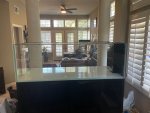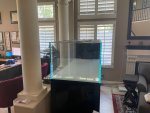In early 2021, I got the itch to upgrade from a Red Sea Reefer 750. At the time, this tank was bursting with life but a bit of a dead end in terms of creativity. Plus, I made a number of mistakes with that build and stocking plan that I was determined to correct in a subsequent build. This is how the Red Sea tank looked at the time:

While I have had a good experience with the Red Sea tank, the long term stability of Red Sea's stand motivated me to choose a different tank builder for its successor. Given my lack of experience in designing and executing aquarium plumbing, I gravitated towards plug and play setups such as Waterbox and Cade. I ended up choosing Cade because (a) I felt confident in the long term stability of their pre-assembled aluminum stands, (b) I really liked the layout of the Cade sump and (c) Algae Barn offered great deals in 2021, including complimentary Marco rock, sand, salt, etc.
Having usurped my dining room for an office during the height of the pandemic, I thought it would be a good idea to utilize a peninsula style tank to serve as a room divider between the office and our entryway. This would also provide me with a lovely vantage point to observe the tank from my desk during the day. As an added kicker, the tank is situated between a couple of early 90s era decorative columns that, to me, gives the tank a bit of an Atlantis aesthetic.


At the time, negative space aquascaping was very popular, and I was enamored with the idea of sculpting something unique to suit the peninsula layout of the tank. I knew I wanted three distinct islands of rock, with an eye towards eventually connecting the islands with some zoanthid-covered Tonga branch rock that I had in the old system. Over the course of several weekends messing around with fast-curing superglue and mortar, and after a few iterations, I felt reasonably happy with the results. I made three stand-alone islands with flat rocks on the bottom (for the sake of stability when placed directly on the glass) that I would pick up and place in the aquarium.



While I have had a good experience with the Red Sea tank, the long term stability of Red Sea's stand motivated me to choose a different tank builder for its successor. Given my lack of experience in designing and executing aquarium plumbing, I gravitated towards plug and play setups such as Waterbox and Cade. I ended up choosing Cade because (a) I felt confident in the long term stability of their pre-assembled aluminum stands, (b) I really liked the layout of the Cade sump and (c) Algae Barn offered great deals in 2021, including complimentary Marco rock, sand, salt, etc.
Having usurped my dining room for an office during the height of the pandemic, I thought it would be a good idea to utilize a peninsula style tank to serve as a room divider between the office and our entryway. This would also provide me with a lovely vantage point to observe the tank from my desk during the day. As an added kicker, the tank is situated between a couple of early 90s era decorative columns that, to me, gives the tank a bit of an Atlantis aesthetic.
At the time, negative space aquascaping was very popular, and I was enamored with the idea of sculpting something unique to suit the peninsula layout of the tank. I knew I wanted three distinct islands of rock, with an eye towards eventually connecting the islands with some zoanthid-covered Tonga branch rock that I had in the old system. Over the course of several weekends messing around with fast-curing superglue and mortar, and after a few iterations, I felt reasonably happy with the results. I made three stand-alone islands with flat rocks on the bottom (for the sake of stability when placed directly on the glass) that I would pick up and place in the aquarium.
Attachments
-
372.6 KB Views: 0
-
372 KB Views: 0
-
258.7 KB Views: 0
Last edited:



